|
西方文明史Western Civilization (1) & (2)
|
英文系
蘇文伶與墨樵、
Wen-ling Su & Joseph Murphy
|
製作日期
July 2011
|
|
 網頁教材
網頁教材 |
|
| 歷史斷代 Historical Periods
|
1.希臘時期 The Greeks
2.中世紀時期 The Middle Ages
3.文藝復興 Renaissance
4.北方文藝復興 Northern Renaissance
5.巴洛克時期The Age of Baroque
6.啟蒙時期Enlightenment
7.浪漫時期The Romantics
8.現代主義 Modernism
9.現代主義研究 Modernism Survey
10.後現代主義 From Modernism to
Postmodernism |
|
Romanticism(ca. 1780-1880) |
|
I.
The Romantic View of Nature
A. Birth
of European Romanticism
a.
Precursors
b. Early 19th-Century
Thought: Schopenhauer, Hegel, Darwin
B.
English Romanticism
C. American
Romanticism
D. Romantic
landscape painting
a.
English:
Constable, Turner
b.
German:
Friedrich
c. American
II. The
Romantic Hero
A. Nationalism
B. The
Romantic Hero
a. Prometheus: Mary Shelley, Byron
b. Goethe’s Faust
III. The Romantic
Style in Art
Heroic themes in painting: Gros,
Goya, Géricault, Delacroix
|
|
I. The Romantic View of Nature |
|
Key Concepts
A.
Nature
B.
Emotion: sentimentality //
nostalgia // melancholy
C.
Imagination: exotic // ecstatic
// fantastic // gothic
D.
the sublime
E.
Subjectivity
F.
Spontaneity
G.
Mysticism
|
|
A. Birth of European Romanticism
|
|
[Precursors]
A.
Jean-Jacques
Rousseau (1712-1778)
1.
“Man is born free, but
everywhere he is in chains.”
2.
“Take the course opposite to
custom and you will almost always do well.”
3.
“I may not be better than other
people, but at least I'm different.”
4.
"The world of reality has its
limits; the world of imagination is boundless."
B.
Sturm und
Drang
1.
1760s-1780s
2.
Originally it’s the title of a
1776 play about the American Revolution.
3.
Translations: “storm and
stress”, “storm and urge”, “passion and energy”, “energy and
rebellion”
4.
Anti-enlightenment:
a.
Storm—the sublime
b.
Stress/urge—emotions
|
The Sorrows of Young
Werther
by Johann Wolfgang von Goethe

http://books.gigaimg.com/avaxhome/avaxhome/2008-05-20/sdwe32.jpg

http://www.goethezeitportal.de/fileadmin/Images/db/wiss/goethe/
schnellkurs_goethe/k_3/werthers_tod.jpg
|
|
The Sublime |
|

http://www.jahsonic.com/Sublime.html
|
A. Edmund Burke,
Philosophical Enquiry into the Origin of Our Ideas of the Beautiful and the
Sublime (1757).
B.
“Burke
divided all aesthetic responses into two categories, the beautiful
and the sublime. The beautiful
includes all that is smooth, regular,
delicate, and harmonious; the sublime, all that is rough,
gloomy, violent, and gigantic.”
C.
“Sublimity among objects of nature includes all that is
untamed and uncivilized, such as the wilder parts of the
countryside, mountains, cataracts, volcanoes, and scenes that are
savage and primitive as opposed to ‘cultivated.’”
http://www.faculty.de.gcsu.edu/~rviau/ids/Artworks/gardenhistory.html
|
|
|
Early 19th Century Thought
|
|
German
Idealism:
“Idealists held that the world is not
something objective that exists independently of individual consciousness. Rather it is human consciousness, the knowing
subject, that builds the world and determines its form”
(Perry 373).
|
|
G. W. F. Hegel (1770-1831) |
|
A.
“The mind can comprehend the
truths underlying all existence and can grasp the essential meaning
of human existence”
(Perry 375).
B.
Geist
= Spirit = Mind
C.
“Hegel believes that world
history reveals a rational process . . . . There is a purpose and an
end to history: the unfolding of Absolute Spirit.”
D.
“Spirit manifests itself in
history through dialectic: thesis –anthithesis—synthesis.”
(Perry
375-7) |

http://www.shelfari.com/books/659683/ThePhilosophy-of-History-(Philosophical-Classics)/tags
|
|
|
Arthur Schopenhauer
(1788-1860) |
|
|
|
Charles Darwin (1809-1882) |
|
Theory
of Natural Selection
A.
Works:
1.
Origin of Species
(1859)
2.
The Descent of Man
(1871)
B.
Survival of the
fittest: Competition leads to
adaptation and if adaptation is successful, to survival.
C.
The governing principles of the
world are not order and harmony but constant and undirected
struggle.
D.
Chance, not a divine plan,
ruled the universe.
E.
Good and bad were defined only
in terms of an ability to survive.
(Lerner,
Meacham, and Burns 906)
Influence: Social Darwinism
A.
The term
appeared ca. 1879.
B.
Definition: “natural selection
operated to determine the superiority of some individuals,
groups, races, and nations over others” (Fiero 212).
1.
Class:
laissez faire capitalism
2.
Nation: nationalism, imperialism
Race: racial superiority
(Lerner,
Meacham, and Burns
907)
 |
|
B. English Romanticism
|
|
A.
Two Generations
|
First Generation
1.
Blake
2.
Wordsworth
3.
Coleridge |
Second Generation
1.
Shelly
2.
Keats
3.
Byron |
B.
Pantheism
“the belief that a divine spirit pervades all things in the
universe” (Fiero 234)
|
|
William Wordsworth (1770 1850) |
|
•For Wordsworth,
poetry is “‘the spontaneous overflow of
powerful feelings,’ which takes its origin ‘from emotion recollected
in tranquility’” (qtd. in Fiero 213).
•In “Lines Composed a Few
Miles above Tintern Abbey,” Wordsworth describes nature as
The anchor of my purest
thoughts, the nurse,
The guide, the
guardian of my heart, and soul
Of all my moral
being.
(ll 109-111) |
|
Tintern Abbey

http://morethangrammar.com/graphics/tinternabbey.jpg |
|
Percy Besshe Shelly
(1792-1882) |
|

http://www.poets.org/poet.php/prmPID/179
|
A.
Poets:
“the unacknowledged legislators of the
world.”
B.
Nature:
the fountainhead of inspiration
C.
The West Wind:
a symbol of creativity
(Fiero 217)
|
|
Ode to
the West Wind
A.
The poem was composed in a wood
near Florence, “on a day when the wind is rising and collecting the
vapors that pour down the autumnal rains. The poet at sunset
observes the turning of the year, the passage into fall. As the
night comes on, a violent tempest of hail and rain descends”
(Bloom
297).
B.
“In
this autumnal advent the poet reads the signs of a creative
destruction” (Bloom
297).
C.
Structure
1.
5 terza-rima sonnets: aba bcb
cdc dd
2.
The first 3
stanzas: the effect of autumn on the
land, the sky, and the sea.
3.
The 4th
stanza: the poet’s situation vs.
natural elements
4.
The 5th
stanza: a prayer or request to the
West Wind, as mover of the seasonal cycle, to assist the poet’s aims
by spreading his message and, thereby, helping him to contribute to
a moral or political revolution paralleling the seasonal change.
(Reiman and Powers, 221) |
|
John Keats (1795-1821) |
|

www.thirdworldorphans.org
|
For Keats, “Art is
more than a response to the human experience of love and nature; it
is the transmuted product of the imagination, a higher form of
nature that triumphantly outreaches the mortal lifespan” (Fiero
217).
|
|

http://englishhistory.net/keats/contents.html
|
Ode to the Grecian Urn
A.
John Keats's sketch of the
Sosibios Vase
B.
Structure:
1.
Stanzas 1-3:
a scene of “wild ecstasy”
2.
Stanza 4:
a religious sacrifice
3.
Stanza 5:
the theme that “Beauty is truth, truth beauty”
 |
|
C. American Romanticism
|
|
A.
Transcendentalism
1. Ralph Waldo Emerson (1803-1882)
2.
Henry David Thoreau (1817-1862)
3. Walt Whitman (1818-1892)
B. New England
Transcendentalism
1.
Time:
1830-1860, three decades before the Civil War
2.
People: Emerson and his
associates
3. Affirmed
a.
Validity of a mode of knowledge
grounded in feeling and intuition
b.
An ethics of individualism that
stressed self-trust, self-reliance, and self-sufficiency
c.
A turn away from modern society
to the scenes and objects of the natural world
d. A faith in a divine
“Principle,” or “Spirit,” or “Soul” (Emerson’s “Over-Soul”) in which
both humanity and the cosmos participate.
(Abrams
326-7)
|
|

http://www.wildernesspress.com/
images/P/meditations_rw_emerson.jpg
|
Emerson’s pantheistic
credo:
“In the woods is
perpetual youth. Within these plantations of God, a decorum and
sanctity reign . . . . In the woods, we return to reason and faith”
(from “Nature”; qtd. in Fiero 225).
|
|
David Henry Thoreau
(1817-1862)
|
|
and Walden,
or Life in the Woods
(1854)
|
|
(left)
http://positiveblatherings.files.wordpress.com/2010/05/henry-david-thoreau-close.jpg
(middle)
http://ecx.images-amazon.com/images/I/51qj3hvv95L.jpg
(right) http://www.trackerkeepers.com/wpcontent/uploads/2010/02/thoreau.gif
|
|
Walt Whitman (1819-1892) |
|

http://www.audioeditions.com/audio-book-images/l/Leaves-of-Grass-292993.jpg |
|
I celebrate
myself, and sing myself
And what I
assume you shall assume
For every
atom belonging to me as good belongs to you
I loaf and
invite my soul,
I learn and
loaf at my ease observing a spear of summer grass.
(Song of Myself 1. ll
1-5)
***********
I bequeath
myself to the dirt to grow from the grass I love,
If you want
me again look for me under your boot-soles.
(Song of Myself 52. ll 9-10)
|
|
D. Romantic Landscape Painting |
|
John Constable (1776-1837)
|
|

John Constable, “The Hay –Wain.” 1821.
NationalGallery. Web.
28 July 2011.
http://musaac.virtualmusicclassroom.co.uk/wpmu/classical-music/
john-constable-romanticism-the-hay-wain-1821-national-gallery-london/

John Constable, “Wivenhoe Park, Essex.” 1816. NGA. Web. 28
July 2011.
http://www.nga.gov/exhibitions/2006/constable/fullscreen/121-022.shtm
|
•“For the most part, Constable's paintings
depict scenes of everyday life in the Stour valley area of the
English countryside where he lived most of his life. Constable's
records of this country have often been considered the visual
counterpart of Wordsworth's poetry.”
•“Constable's art evokes a benevolent,
natural universe where man, animal, and landscape are joined in the
most element harmony. “
http://www.arts.ualberta.ca/~dmiall/TinternRev/Jillian_0.htm
|
|
J.M.W. Turner (1775-1851) |
|

J.M.W. Turner, "Rain, Steam, and Speed“, 1844.
Mtholyoke.
Web. 28 July 2011.
http://www.mtholyoke.edu/courses/rschwart/
pastoral/pastoral.html
|
A. the painter of light
B. Romantic Visionary
C. “In Turner's paintings light
does not heighten reality but rather diminishes it. Light dissolves
the solid form and renders it mysterious and remote. As a result,
nature is transformed and made mysterious.“
D. “He
takes the trend towards looking at the sublime aspects of landscape
and turns it into a universal metaphor of man vs. destiny. Nature is
presented as an elusive and intangible force, a bodiless energy that
will ultimately conquer and destroy.”
http://www.arts.ualberta.ca/~dmiall/TinternRev/Jillian_0.htm
|
|
|
Caspar David Friedrich
(1774-1840) |
|

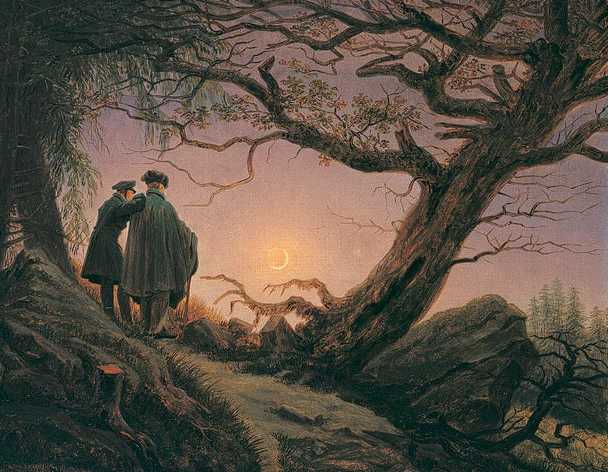
(left)
Caspar David Friedrich, “Wanderer above the Mists.” c. 1818.
Oneonta. Web.28 July 2011.
http://employees.oneonta.edu/farberas/arth/arth110/arth110_sl20.html
(right)
Caspar David Friedrich, “Two Men Contemplating the Moon.” 1825-1830.
Wikipedia. Web. 28 July 2011.
http://en.wikipedia.org/wiki/File:Caspar_David_Friedrich_Two_men_contemplating_the_Moon.jpg
|
|
American Romanticist Painting
|
|
Thomas Cole
(1801-1848)
|
|
A.
The Hudson River School
(1830s-1840s)
B.
“Thomas Cole was the leader of
the Hudson River School, named after the Hudson River region of New
York State, which we recognize as creating the first American style
of painting. Cole found nature awe inspiring: he interpreted it as
reflecting the hand of God and was therefore reverential toward the
wilderness.”
http://www.ncmoa.org/artnc/object.php?themeid=3&objectid=29 |
|
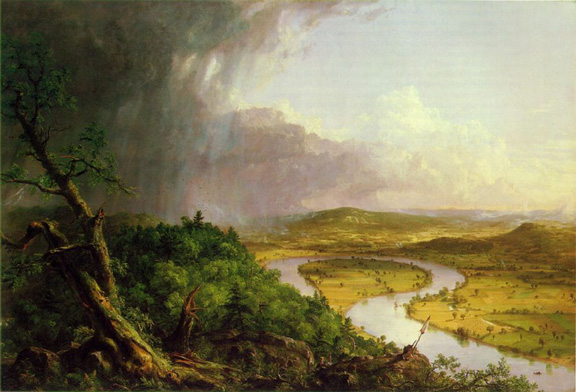
Thomas Cole, "The Oxbow," 1836.
Evansville. Web.
28 July 2011.
http://faculty.evansville.edu/rl29/art105/img/cole_oxbow.jpg
|
“Cole relies heavily on
European conventions of landscape painting to convey the visual
representation of the struggle between wilderness and civilization.”
•“The
dramatic storm clouds over the wilderness speak of the uncontrolled
power of nature, but also of the sublimity of this power.”
•“The
soft greens and yellows and the gentle rolling landscape of the
farms suggest that the pastoral civilization that replaces the
wilderness is as beautiful in its order as nature is in its
sublimity.”
http://xroads.virginia.edu/~cap/NATURE/oxbow.html
|
|
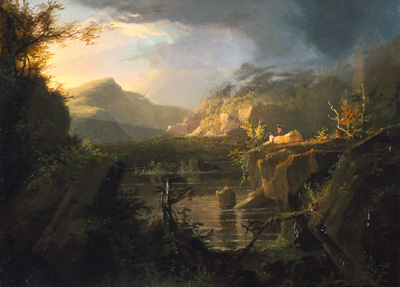
Thomas Cole, Romantic Landscape, 1826.Ncmoa. Web. 28
July 2011.
http://www.ncmoa.org/artnc/object.php?themeid=3&objectid=29

Thomas Cole, “Landscape Scene from the Last of the Mohicans.” 1827.
SmartnMore. Web.28 July 2011.
http://www.swarthmore.edu/Humanities/kjohnso1/pictures/mohicanscole.jpg
|
Look closely at the upper
left corner, above the mountain peak. “You may be able to see
faintly painted rays of light that give the scene a spiritual
feeling.”
“The
people . . . are American Indians, the first inhabitants of the New
York and New England wilderness . . . . Their presence confirms this
is an America landscape, not European.”
http://ncmoa.org/artnc/object.php?objectid=29
|
|
Albert Bierstadt (1830-1902) |
|
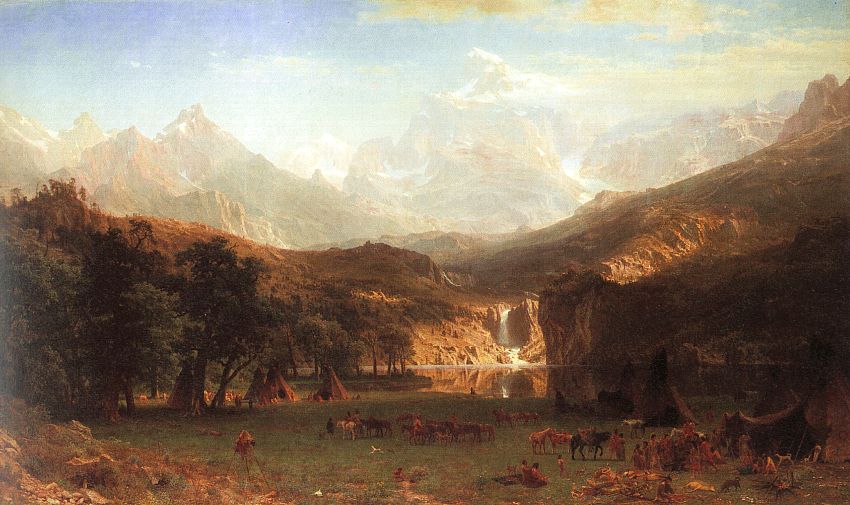
Bierstadt, “The Rocky Mountains, Landers Peak.” 1863.
Artunframed.
Web. 28 July 2011.
http://www.artunframed.com/images/artistsusaa/bierstadt1.gif
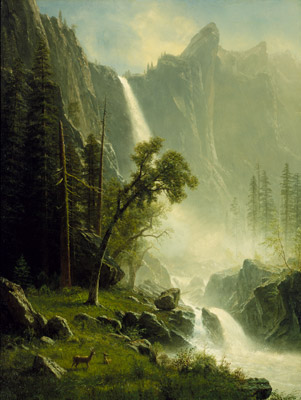
Albert Bierstadt, “Bridal Veil Falls, Yosemite.” 1871-73.
Ncmoa.
Web. 28 July 2011.
http://www.ncmoa.org/artnc/artifact.php?artifactid=16
|
A. the Western frontier as an
American Garden of Eden
B. On Albert Bierstadt, Bridal
Veil Falls, Yosemite, 1871-73
“Bierstadt’s vast panoramas of the Rockies
and Sierra Nevada, their skies often turbulent and shot through with
sunlight, introduced Americans to a majestic wilderness, awesome but
unthreatening, and well worth possessing.”
C. “His
many paintings of Yosemite are indeed biblical in grandeur, imbued
with the sense that divinity dwelled within the wilderness.”
http://www.ncmoa.org/artnc/artifact.php?artifactid=16
|
|
Frederic Edwin Church
(1826-1901) |
|
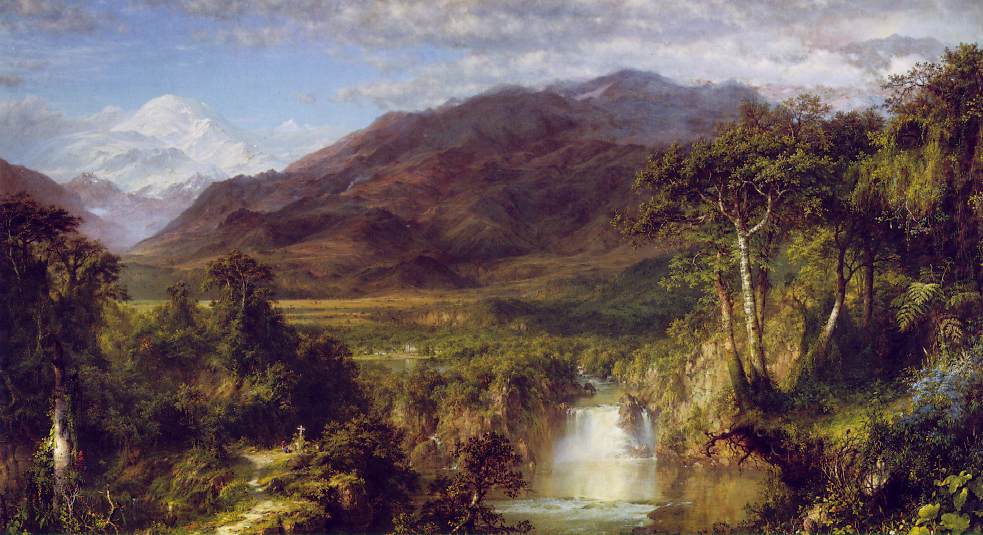
Church, Heart of the Andes, 1859. Artchive. Web. 28
July 2011.
http://www.artchive.com/artchive/C/church/heart_of_andes.jpg.html
|
A. invested his vistas with a heroic and quasi-religious spirit
B. “In the 1850s . . . Church traveled to South America and made
sketches that were the basis of a great Andean panorama. Church
painted nature with uncanny fidelity and an abiding sense of awe.
His landscapes embodied America's belief that the opening of
frontiers and territorial expansion were the nation's destiny.”
http://www.wga.hu/frames-e.html?/html/c/church/
 |
|
II. The Romantic Hero
|
|
“While Enlightenment writers studied the social animal,
the romantics explored the depths of their own souls.”
(Fiero 5th
ed.700)
“. . . whereas the literary hero defended the traditions
and moral values of a society, the Romantic hero might challenge or
seek to reform them”
(Fiero, 6th ed., 237).
|
|
A.
Nationalism |
|
Definition:
“an ideology (or belief system) grounded in a people’s sense of
cultural and political unity”
(Fiero 237)
|
|
Nationalism
←→
Liberalism
|
|
After the French Revolution
(1789), and thereafter, in resistance to the imperialistic expansion
of Napoleonic France:
nationalism
= love of liberty
= ideals of self-determination
|
|
Nationalism
←→
Conservativism
|
|
A.
An appreciation/veneration of the past
B.
Demanding the sacrifice of individual’s freedom for the
common good
|
|
National Identity |
|
Nation
= narration
= an imagined community
= a system of cultural signification
(Homi Bhabha, Nation
and Narration)
Nation
= a system of cultural signification
1.
Creation of national
institutions
- Participation of
national rituals (holidays, festivals)
- Identifying with a
national community
- National imagery:
heroes
|
|
Nationalism vs. Romanticism |
|
A.
Romantic writers insisted on
the uniqueness of cultures by idealizing history and community.
B.
Germany:
1.
the Volk (the common people)
2.
Volksgeist (the spirit of the
people)
|
|
Extreme Nationalism |
|
A.
German racial nationalists
B.
“Like their Nazi successors,
Volkish thinkers claimed that the German race was purer than, and
therefore superior to, all other races”
(Perry 453).

|
|
B. The
Romantic Hero
|
|
1.
“Gifted
with intellect and imagination, the
hero is at odds with the ‘common herd’ of mankind.”
2.
“The
hero’s desires are insatiable; his is
a will not satisfied with ordinary things.”
3.
“The
Promethean hero: an over-reacher who
unsettles traditional moral categories.”
http://personal.georgiasouthern.edu/~dougt/hero.htm
|
|
Types of the Promethean Hero |
|
1.
The Faustian hero:
Goethe’s Faust; Victor Frankenstein
2.
The Byronic hero:
“aristocratic, darkly handsome,
manly, brooding, brilliant, erotic, melancholy, indomitable.”
3.
The Gothic villain-hero
http://www.georgiasouthern.edu/~dougt/hero.htm
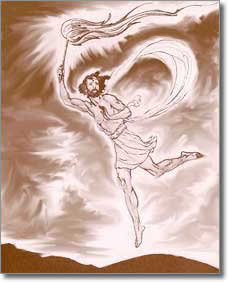
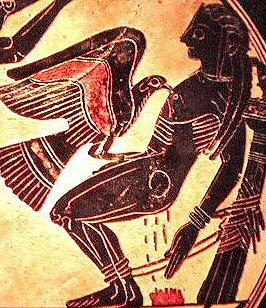 |
|
Goethe’s Faust
|
|
Faust:
If ever I say to the passing
moment
“Linger for a while! Thou
art so fair!”
Then you may cast me into
fetters,
I will gladly perish then
and there!
Then you may set the
death-bell tolling,
Then from my service you are
free,
The clock may stop, its hand
may fall,
And that be the end of time
for me!
(Faust,
ll. 462-470; Fiero 252)
|
|
Mary Shelley
|
|
Frankenstein;
or, The Modern Prometheus
“I doubted at first whether
I should attempt the creation of a being like myself, or one of
simpler organization; but my imagination was too much exalted
by my first success to permit me to doubt of my ability to give life
to an animal as complex and wonderful as man” (from Frankenstein,
Fiero 241).
“No one can conceive the
variety of feelings which bore me onwards, like a hurricane, in the
first enthusiasm of success. Life and death appeared to be ideal
bounds, which I should first break through, and pour a torrent
of light into our dark world. A new species would bless me as its
creator and source; many happy and excellent natures would owe
their being to me. No father could claim the gratitude of his
child so completely as I should deserve theirs” (from
Frankenstein, Fiero 241).
|
|
The Byronic Hero
|
|
George Gordon
Byron
(1788-1824)
A.
Works:
1.
Childe Harold’s Pilgrimage
(1813-1814)
2.
Manfred
(1816-1817)
3.
Don Juan
(1819-1824)
B.
the Byronic hero:
1.
A rebel
2.
Isolated from society
3.
Moody by nature or passionate
about a particular issue
4.
Arrogant, confident, abnormally
sensitive and extremely conscious of himself
5.
Rejects the values and moral
codes of society
6.
Characterized by a guilty
memory of some unknown sexual sin
7.
A figure of repulsion as well
as fascination
http://www.umd.umich.edu/casl/hum/eng/classes/434/charweb/CHARACTE.htm
 |
|
III. The Romantic Style in Art
|
|
Major Themes
A.
Individualism
B.
Patriotism
C.
Nationalism
|
|
Heroic Themes in Painting |
|
Antoine-Jean Gros (1775-1835) |
|
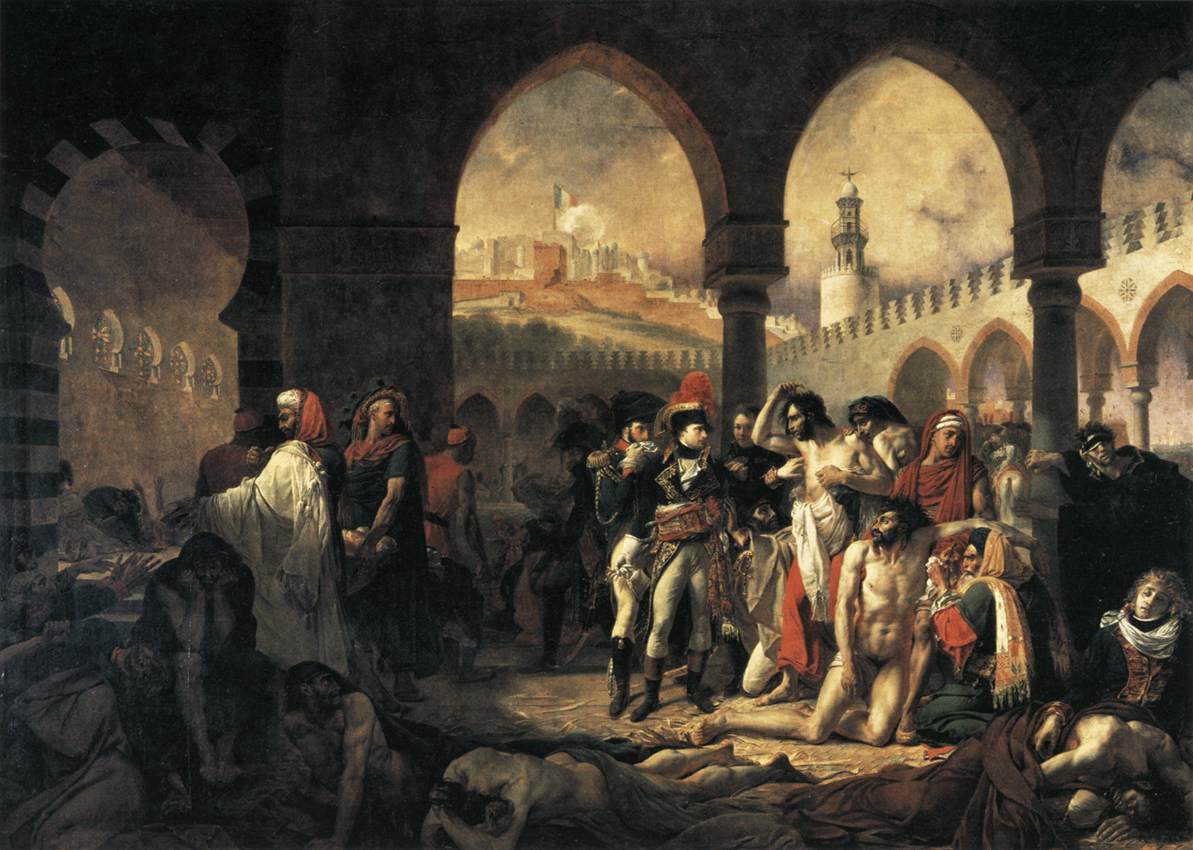
Antoine-Jean Gros, “Napoleon on the Battlefield of Eylau.”
1808.
Actclon. 28 July 2011.
http://www.artclon.com/artist/antoine+jean-gros/ |
|
Francisco Goya
(1746-1828) |
|
|
|
Théodore Géricault (1791-1824) |
|
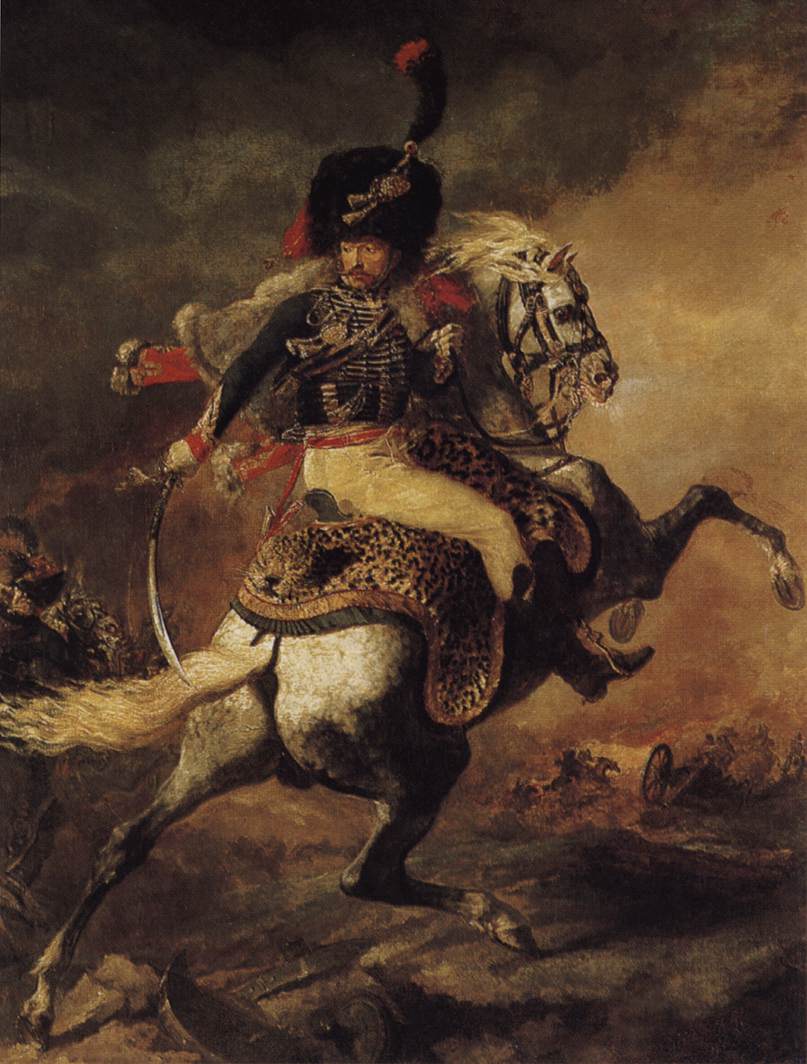
Théodore Géricault, “An Officer of the Chasseurs Commanding a
Charge,” 1812.
WGA. Web. 28 July 2011.”
http://www.wga.hu/art/g/gericaul/1/101geric.jpg
|
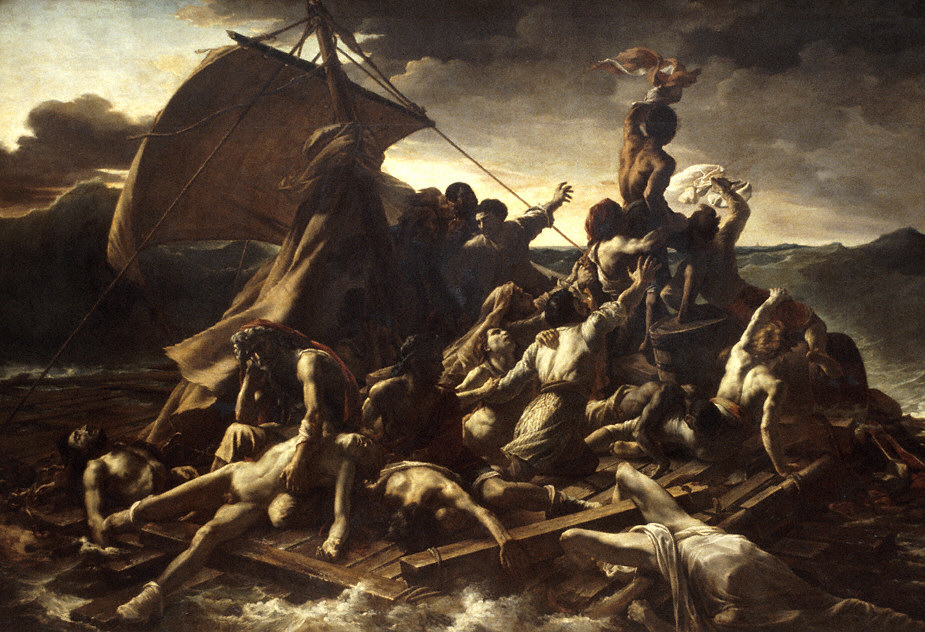
Théodore Géricault, “The Raft of the Medusa.” 1819. UWC. Web.
28 July 2011.
http://rock.uwc.edu/facultypages/pkudrna/New%20Folder%20(2)/nff0055.jpg
“The
Raft of the Medusa marks the first
appearance in painting of 'the ugly' and thereby proclaims its
scrupulous respect for the truth, however repulsive the truth might
be. This concern for truth is integral to the Romantic temperament.”
“Géricault chose a dramatic
episode — the wreck of the frigate Meduse, which had set off with a
French fleet on an expedition to Senegal, and had been lost in July
1816.”
“The
most horrifying part of the shipwreck had been the drama of 149
wretches abandoned on a raft with only some casks of wine to live
on, and the ensuing drunkenness and abominations. When the frigate
Argus found the raft, after many days, she was only able to rescue
fifteen survivors, of whom five died after being brought ashore.”
http://www.wga.hu/frames-e.html?/html/g/gericaul/1/ |
|
|
Eugène Delacroix
(1798-1863) |
|
|
|
 |
|
Works Cited
|
|
Abrams, M. H. A Glossary of Literary Terms. 7th
ed. Fort Worth, Harcourt Brace, 1999.
Bhabha, Homi, ed. Nation and Narration. London: Routledge,
1990.
Bloom, Harold. The Visionary Company. Ithaca: Cornell UP,
1971.
Fiero, Gloria. The Humanistic Tradition. Vol. 2. 6th
ed. New York: McGraw-Hill, 2011.
Lerner, Robert E., Standish Meacham, and Edward McNall Burns.
Western Civilizations. 13th ed. New York: Norton,
1998.
Perry, Marvin. Western Civilization: A Brief History. 4th
ed. Boston: Houghton Mifflin, 2001.
Reiman, Donald H. and Sharon B. Powers. Shelley’s Poetry and
Prose. New York: W. W. Norton, 1977.
|
|
|